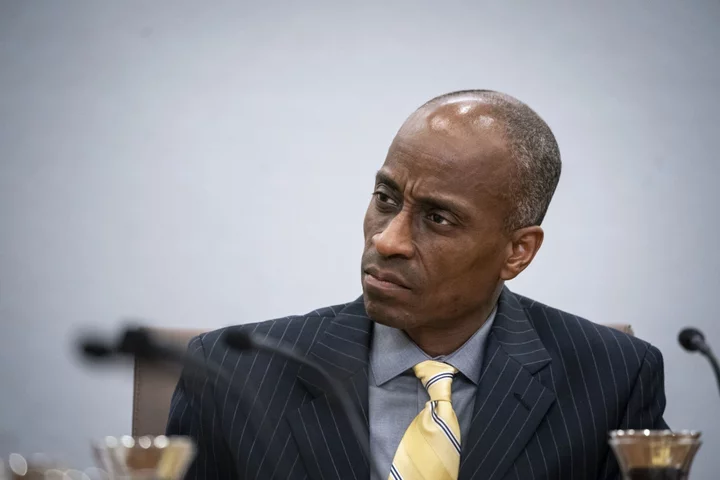Federal Reserve Governor Philip Jefferson signaled the central bank is inclined to keep interest rates steady at its next meeting in June to give policymakers more time to assess the economic outlook, but such a decision wouldn’t mean hikes are finished.
“A decision to hold our policy rate constant at a coming meeting should not be interpreted to mean that we have reached the peak rate for this cycle,” Jefferson, recently nominated to be Fed vice chair, said Wednesday in a speech on financial stability and the economy. “Indeed, skipping a rate hike at a coming meeting would allow the Committee to see more data before making decisions about the extent of additional policy firming.”
Jefferson’s comments followed growing expectations in recent days among investors that the central bank would raise rates in June for an 11th straight time.
Following the remarks, traders pared back bets to around a 40% probability of a June Fed hike, down from a more than 70% chance priced in earlier in the trading day.
As Jefferson spoke, another voting member of the Fed’s policy committee also reiterated his support for skipping a rate increase next month.
“I think we can take a bit of a skip for a meeting,” Philadelphia Fed President Patrick Harker said Wednesday during an event at the bank. “I am definitely in the camp of thinking about skipping any increase at this meeting.”
The Federal Open Market Committee has raised rates by 5 percentage points in the past 14 months to curb inflation running more than double their 2% target. With their benchmark rate now in a 5% to 5.25% target range following a quarter-point increase earlier this month, Fed Chair Jerome Powell has said that policymakers could afford to watch the data and the evolving outlook.
While US banks have stabilized since a series of failures in early March, the strains are likely to lead to a further tightening in credit that will weigh on economic activity, Jefferson said.
‘Quite Slow’
“I expect spending and economic growth to remain quite slow over the rest of 2023, due to tight financial conditions, low consumer sentiment, heightened uncertainty, and a decline in household savings that had built up after the onset of the pandemic,” he said.
“Inflation has come down substantially since last summer, but it is still too high, and by some measures progress has been decelerating recently, particularly in the core services sector,” Jefferson added.
Jefferson said it was difficult to forecast the US outlook in part because the amount of tightening of credit by banks and its effect on the US economy is not yet clear.
In a speech that mostly dealt with financial stability, the Fed governor singled out the office sector and nearby retail properties as a potential problem with remote work becoming more common in the wake of the Covid-19 pandemic.
“The weakness in some sectors of commercial real estate will affect the credit quality of those types of commercial real estate loans and thereby place strains on lenders with high concentrations of those loans,” he said.
Jefferson’s speech was among the last by top Fed officials before the central bank goes into a self-imposed blackout in advance of the June meeting. Officials will get an important update on the economy with the Friday report on employment, expected to show a gain of nearly 200,000 jobs.
--With assistance from Liz Capo McCormick.
(Updates with market reaction, Harker comments starting in fourth paragraph.)

